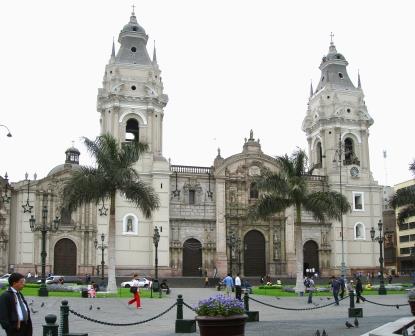
Peru is a country in northwestern South America comprising 1,285,216 sq. km. (798,596 sq. mi.), bordering the Pacific Ocean to the west, Ecuador and Colombia to the north, Brazil and Bolivia to the east, and Chile to the south. As of 2016, Peru has an estimated population of 30,741,062. Home to several advanced cultures for thousands of years, modern Peru was first politically unified by the vast Inca Empire in the 15th century. Spain conquered the Inca in the 16th century and established the Viceroyalty of Peru, bringing European administration and Roman Catholicism to the region. Due to its abundant silver mines and other natural resources, Peru quickly became the most important of Spain’s New World holdings, and the viceregal capital of Lima was the center of culture, wealth, power, justice, and religion for the entire region. With the Archbishop of Lima at the head of the church in Peru, many religious orders established missions and monasteries there, and the tribunal of the Inquisition worked to exterminate heresy in the colony.
Peru declared independence in 1821 and ultimately drove the Spanish out in 1824, but the highly stratified nation initially lacked a tradition of self-government and has vacillated between military rule and elected government for almost two centuries. Throughout this time, the various governments of Peru continued to rely on the Catholic Church as a unifying and stabilizing element in Peruvian society. In 1924, the anti-capitalist and anti-imperialist “Aprista movement” was founded, and its power in Peruvian politics has waxed and waned in inverse correlation to the military’s ever since. An Aprista-influenced assembly signed a new constitution in 1979 and ushered in a new era of democracy in 1980, but severe economic turmoil and the rise of a violent guerrilla movement led to the election in 1990 of President Alberto Fujimori, who orchestrated a coup in 1992. Although initially successful in reviving the economy and combatting the guerrillas, Fujimori was forced to resign under suspicion in 2000 and later convicted of corruption and human rights violations. Governed by democratically-elected governments since 2001, poverty and unemployment rates have fallen dramatically in Peru in the last decade, giving it one of the strongest economies in Latin America.
Recent studies estimate that 76% of Peruvians are Roman Catholic, 17% are Protestant (mainly evangelical), and 4% are atheist or agnostic. The remaining 3% are comprised of Seventh-day Adventists, members of the Church of Jesus Christ of Latter-day Saints, Jehovah’s Witnesses, Israelites of the New Universal Pact, Baptists, Anglicans, Assemblies of God, Jews, Baha’is, Buddhists, International Society of Krishna Consciousness (Hare Krishnas), and Muslims. Some indigenous groups in the Amazon or Andean highlands practice traditional pre-Columbian or syncretic faiths.
The government of Peru generally respects religious freedom through its laws and practices. The current Constitution, which took effect in 1993, provides for freedom of conscience and religion, and protects the free exercise of religion so long as it does not disturb public order or morals. It also bars discrimination based on religious affiliation, persecution on the basis of ideas or beliefs, and guarantees the right to privacy of religious conviction.
Government policies provide preferential treatment to the Catholic Church in education, taxation, immigration of religious workers, and other areas. Peru has historically had an official relationship with the Catholic Church, with each of the various governments relying on the Catholic Church as a unifying and stabilizing element in Peruvian society. In 1980, Peru entered into an international agreement with the Vatican which established a formal separation of church and state, but also granted special legal status to the Church. The government pays stipends to some Catholic clergy and all Catholic dioceses which are not available to other religious groups.
In July of 2016 the government made it easier for non-Catholic religious groups to register with the government and obtain tax, visa, and other exemptions.
Peru has a civil legal system. The Constitution has the highest rank, in second place are the Laws and Legislative Decrees, in third place, the Supreme Decrees issued by the Executive Branch and so on.
From Peru: Law and Religion Framework Overview (2018), prepared by Dorsey & Whitney (notes omitted).
For more information see the links below: